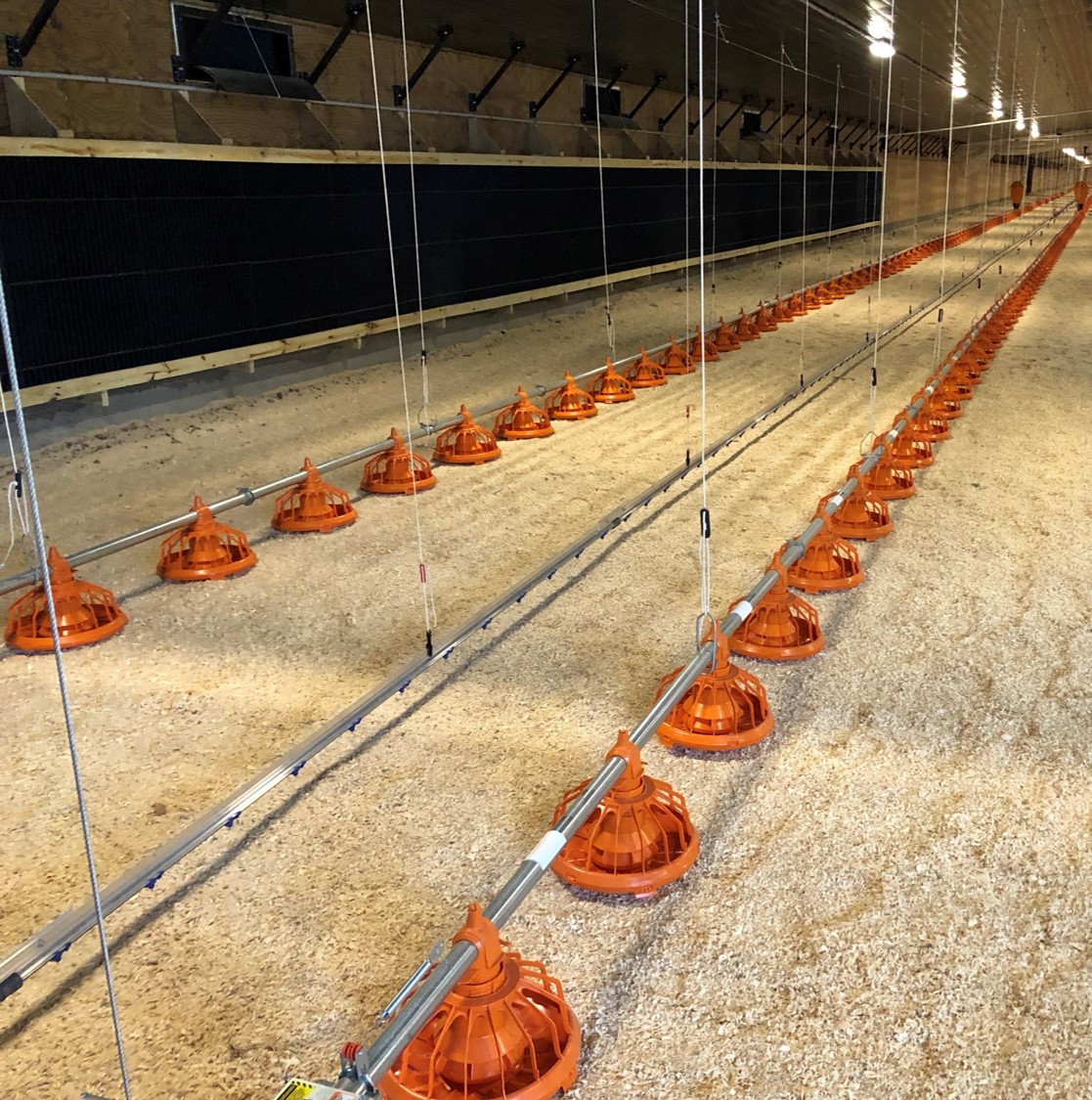Projets de recherche

- Période: 2020-08-01 2023-03-31
Titulaire
Cloutier, Laetitia
Mot(s) Clé(s)
Volaille Porc Environnement Fumier
Informations complémentaires
Ce projet est financé par Agriculture et Agroalimentaire Canada (AAC; programme Agri-Science). Merci aux partenaires : CRSAD, IRDA, INRAE et UFRGS.
Présentation du projet
Project objective
The objective is to reduce dietary crude protein in broilers and pigs by fine-tuning amino acid utilization to reduce nitrogen excretion and the associated environmental impacts, while improving animal health to reduce the use of antibiotics without changing growth performance. Different low crude protein (LCP) strategies will be tested in broilers and pigs and the environmental impact will be evaluated by performing life cycle assessment of those LCP feeding strategies in the Canadian context.
Project purpose
This research program focuses on optimizing the use of nitrogen (N) resources in the context of sustainable development of pig and poultry productions facing major environmental, economic, and societal challenges. The general objective is to reduce the intake of crude protein (CP) by optimizing its use by animals and adjusting the intake as accurately as possible to the requirements of the animals in order to avoid a reduction in performance with LCP feeding strategies. Previous studies have shown that the reduction of CP reduces N excretion, which is associated to acidification, eutrophication, and climate change (through the emission of greenhouse gases; GHG). Another advantage of the LCP feeding strategies is the improvement of animal health, which could result in a reduction of the use of antibiotics, another very important factor for the sustainability of these productions.
The reduction of CP is now possible by using feed-grade amino acids, which replace those supplied by raw materials of plant origin. However, more studies are needed to reduce CP without changing growth performance and meat quality, especially in broilers. It is for this reason that a consortium of universities, public research partners and two companies is proposing to set up a project aiming to optimize the use of nitrogen by pigs and broilers to improve the sustainability of these productions, reducing their environmental footprint, including GHG emission. This will also improve the perception of these productions through reduced use of antibiotics and improved well-being, while remaining cost-effective. At the academic level, having specialists in animal nutrition, gaseous emissions from manure (housing, storage and spreading), and environmental assessment will allow a very interesting synergy to reduce environmental impact of livestock system. With this consortium of national and international partners, the impacts of this research will extend well beyond Quebec and Canada.
Problem addressed by the project
Nitrogen excretion is a major concern for the sustainability of animal production. It is responsible for soils acidification, water eutrophication, odor, and can lead to respiratory diseases and poorer growth performance of animals (Webb et al., 2014; Aziz and Barnes, 2010). Recent European directives aim to reduce the level of N emissions in the atmosphere (Directive 2010/75/EU) and the new Canadian regulations regarding NH3 emissions for worker’s health (PASAF, 2018). Besides, as the world population is expected to reach nearly 10 billion by 2050, demand for animal products will increase strongly over the coming decades and non-ruminant livestock farming will be promoted, due in part to lower production of enteric CH4 than cattle (Fogarty, 2007). This will undoubtedly lead to an increase in environmental impacts and GHG production. Although poultry production, and to a lesser extent pork production, is among the livestock products with the least impact on the environment, the widespread consumption of poultry products means that it is also important to consider. The environmental impacts associated with chicken and pork come mainly from feed ingredient production. For instance, according to FAO (2013), 48% and 57% of GHG emissions come from feed production in swine and poultry production, respectively. Feed formulation and ingredient selection are therefore levering to reduce environmental footprint (Garcia-Launay et al., 2018; Nakamura and Itsubo, 2019). One option is to minimize the impact of some nutrients on the environment, including nitrogen. Meat production depend on high-protein diets, such as soybean meal produced in Brazil or in the United States. Thus, in the European context of production, the use of Brazilian or American soybean meal as the main source of protein has a very important impact on GHGs, in addition to being associated with a strong eutrophication potential, acidification and agricultural land use (Tallentire et al., 2017; Sutton et al., 2008). The research carried out in this project will therefore have an international scope. Other GHG emissions come from manure (27% for pork and 6-20% for poultry; FAO 2013). The reduction in the N content of feed will therefore have a direct impact on the nitrogen content in manure and slurry and, consequently, on the emissions (N20, NH3) to be measured in this project. It should be noted that the BABE unit that will be used to quantify gas emissions in this project is a unique facility in Canada, not available in France and Brazil that will truly quantify emissions and even improve LCA equations.
As a result, this project is in direct adequacy with the Agri-Science program’s priority: “Enhance efforts in clean growth, environment, and climate change, such as addressing environmental challenges and adaptation to changing climate, agricultural impacts on air, water and soil and reducing Green House Gas (GHG) emissions […]”, and with the priority of the Canadian Agricultural Partnership, which is to improve environmental sustainability and climate change. In addition, protein reduction has the potential to reduce digestive disorders leading to diarrhea and wet litter, with significant impacts on production costs, animal health and welfare, and antibiotic resistance (Létourneau-Montminy et al., 2018; Wang et al., 2018). All of these expected results are in adequacy with priorities of the Canadian Agricultural Partnership, which are to improve public trust, considering a potential reduction of the use of antibiotics, and to enhance science, research and innovation to improve productivity of broiler and pig producers, considering a potential reduction on production costs. Since this project is addressing health issues and environmental sustainability for pigs and broilers, this project is likewise in adequacy with industrial priorities. Indeed, environment and poultry health are two of the six main priorities targeted by the Canadian Poultry Research Council (CP-RC, 2018). For Canadian swine producers, this project is also in adequacy with priorities targeted by Swine Innovation Porc (SIP), who represent the whole Canadian swine industry, which are “Reducing feed costs and improving feed efficiency” and improve “Environmental sustainability” (SIP, 2018).
The involvement of Ajinomoto Animal Nutrition Europe (AANE) in a project led by a research team composed of Brazilian, Canadian and French universities and research centers will allow a very wide dissemination of the strategy developed with Canada as leader which will give a very good visibility focused on the sustainability of animal productions. This project will therefore focus on feeding strategies to reduce dietary protein, and thus the use of soybean meal, without altering animal performance. The environmental effects of reduced nitrogen excretion will be assessed precisely in this project, an information found scarcely in literature.
Objectives
The objective is to reduce dietary crude protein content in broilers and pigs by fine-tuning amino acids to reduce nitrogen excretion and the associated environmental impacts, while improving animal health to reduce the use of antibiotics without changing growth performance. Different LCP strategies will be tested on broilers and pigs and environmental impacts and gas emissions will be evaluated. More specifically through:
1. Evaluation of different LCP strategies to reduce nitrogen excretion and improve health without compromising the growth performance and meat quality of broilers and pigs,
2. Evaluation of the impact of LCP feeding strategies (NH3, CO2, CH4 and N2O) in a controlled environment in broiler chickens and pigs,
3. Evaluate the potential reduction of greenhouse gas emissions while treating anaerobically the low-protein broiler manure and pig slurry,
4. Assessing the environmental benefits of LCP feeding strategies in Canadian broiler and pig productions using Life Cycle Assessment.
Those objectives will be addressed through two activities. The first activity will be scientifically led by Marie-Pierre Létourneau Montminy from Université Laval and will focus on the objectives 1, 2 and 4 with the collaboration of other researchers from Canada, France and Brazil. The second activity will be scientifically led by Rajinikanth Rajagopal, an AAFC scientific researcher from Sherbrooke Research and Development Center and will focus on objective 3.
Expected results
This project will first, in objective 1, validate This project will first, in objective 1, validate This project will first, in objective 1, validate This project will first, in objective 1, validate This project will first, in objective 1, validate This project will first, in objective 1, validate This project will first, in objective 1, validate This project will first, in objective 1, validate This project will first, in objective 1, validate This project will first, in objective 1, validate This project will first, in objective 1, validate This project will first, in objective 1, validate This project will first, in objective 1, validate This project will first, in objective 1, validate This project will first, in objective 1, validate This project will first, in objective 1, validate This project will first, in objective 1, validate This project will first, in objective 1, validate This project will first, in objective 1, validate This project will first, in objective 1, validate This project will first, in objective 1, validate the the the impacts of LCP strategies on growth performance, N retention, and meat quality. This will allow comparing the N balance between LCP diet and the conventional diet and to highlight the key of success. Relative NH3 and GHG reductions of LCP diets compared to a conventional diet for broilers and pigs will be evaluated in objective 2. In objective 3, an evaluation of the impact of LCP on reduction of greenhouse gas emissions from manure storage and digestate will be done. Finally, a life-cycle analysis (LCA) will be realized in objective 4 to validate the impact of an LCP diet in a global perspective which will give us the real impact of the implementation of those type of strategies. LCA will identify the most important and sensitive points in the broiler and pig chain that can be used to tackle climate change. This study will also provide strategies to enhance efforts in clea growth by reducting agricutlural impacts on air, water, and soil, and promoting new forms of production and commercialization of agricultural products.



